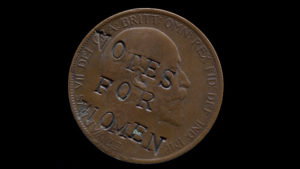When we think about the 1920s in the U.S., it’s easy to conjure up images of women in flapper dresses and feather boas, dancing to the music of Louis Armstrong. We don’t usually think of the uphill struggle for one of the most important victories in women’s rights Рwomen’s suffrage.
While the battle for women’s right to vote raged on in America, it was also taking place across the pond in Britain. This coin is an example of one way the girls of that era made their voices heard – by illegally stamping currency with the phrase “votes for women.” There is a beautiful symbolism in stamping this phrase over the head of King Edward VII, who opposed much of what early 19th century British people were for. This stamping allowed the suffragettes to spread their message to a much wider audience. Aside from coin stamping, these women conducted hunger-strikes, protests and other acts of civil disobedience. Thousands were jailed as a result, but this did not stop the movement. In 1918, women in the United Kingdom over the age of 30 were granted the right to vote through the Representation of the People Act, and the act was extended to women 21 and older in 1928.
Thinking of the success these women were able to achieve makes me grateful to live in an age where I can make my voice heard through our political process. I know that I often take important rights like voting for granted. We should think about these things more often, and be engaged in systems that our grandmothers and great grandmothers did not have the right to. While we have come far, though, we still have a lot of work to do for equality. We should approach these issues with the same fearlessness the suffragettes did, and do our best to make it easier for the next generation to succeed.
-Lauren Payton
Junior Girl
Girl Museum Inc.


Beautiful Lauren, your words are eloquent, informative and certainly eye-opening. There are many of us who tend to forget the struggles of our older generations and take things for granted now. We need to exercise the rights that were fought for and stay in the battle to accomplish much more for future generations. Your post was well written with a call to action that I know will resonate with many of us. Keep pushing; your ideas and ideals will not go unnoticed. I am very proud to be a part of your initiative to bring change.